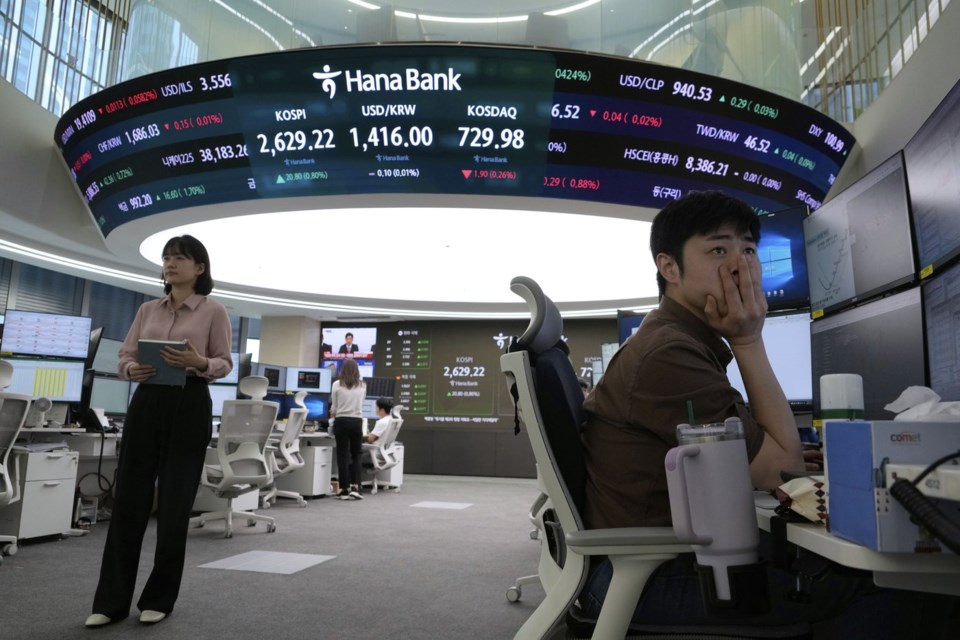TOKYO (AP) ÔÇö Asian shares were mostly higher Wednesday as a cautious sense of relief spread through regional markets after the U.S. and China agreed to a in their
Japan's benchmark Nikkei 225 lost 0.8% to 37,874.59. Australia's S&P/ASX 200 shed 0.1% to 8,260.40.
┬ÚÂ╣┤ź├ŻAV Korea's Kospi surged 1.1% to 2,635.86. Hong Kong's Hang Seng jumped 1.1% to 23,367.57, while the Shanghai Composite gained 0.1% to 3,377.75.
The relief over the trade truce between the U.S. and China is tepid among global businesses and investors given uncertainty over how long it might last and where tariffs might go in the months ahead.
ÔÇťIn the absence of a lasting deal, uncertainty over where tariff rates will settle and the impact of those already implemented will remain key factors in our macroeconomic forecasts,ÔÇŁ said Brian Coulton, chief economist at Fitch Ratings.
A report overnight that showed U.S. last month helped drive buying that pushed the S&P 500 up 0.7%, to 5,886.55. The Dow Jones Industrial Average fell 0.6% to 42,140.43, and the Nasdaq composite climbed 1.6% to 19,010.08.
The S&P 500 fell its last month, but has since recovered on hopes that President Donald Trump will ease his on trading partners worldwide before they create a recession and send inflation spiking higher.
The S&P 500, which sits at the center of many 401(k) accounts, is back within 4.2% of its all-time high set in February and positive again for the year so far.
TuesdayÔÇÖs report said that even with all the uncertainty around trade, and even with many businesses rushing to , inflation slowed to 2.3% last month from 2.4% in March.
Such data pulls the economy further from a worst-case scenario called ÔÇťstagflation,ÔÇŁ where the economy stagnates but inflation remains high. The Federal Reserve has no good way to fix that toxic combination. It could try to lower rates to help the economy, for example, but that would likely worsen inflation in the short term.
Even with TuesdayÔÇÖs encouraging report, economists and analysts say inflation may still run higher in coming months because of TrumpÔÇÖs tariffs. That will likely leave the Fed waiting for more data to guide their decision on whether and when to cut interest rates in order to help the economy.
ItÔÇÖs similar to the wait that investors in general are enduring. With the Fed set to make no moves on interest rates for the time being, markets will likely trade ÔÇťwith negotiation and reconciliation headlines,ÔÇŁ according to Alexandra Wilson-Elizondo, global co-head and co-chief investment officer of multi-asset solutions within Goldman Sachs Asset Management.
On Wall Street, stocks in the artificial-intelligence industry were strong. Nvidia rose 5.6% and was the biggest single force pushing upward on the S&P 500. ItÔÇÖs Saudi ArabiaÔÇÖs sovereign wealth fund-owned AI startup Humain to ship 18,000 chips to the Middle Eastern nation to help power a new data center project.
In the bond market, Treasury yields ticked higher with hopes for the U.S. economy. The yield on the 10-year Treasury rose to 4.48% from 4.45% late Monday.
The two-year Treasury yield, which moves more closely with expectations for Fed action, ticked up to 4.01% from 3.98%.
In energy trading, benchmark U.S. crude fell 44 cents to $63.23 a barrel. Brent crude, the international standard, declined 46 cents to $66.17 a barrel.
In currency trading, the U.S. dollar edged down to 147.16 Japanese yen from 147.21 yen. The euro cost $1.1192, up from $1.1188.
___
AP Business Writer Stan Choe in New York contributed.
Yuri Kageyama, The Associated Press




